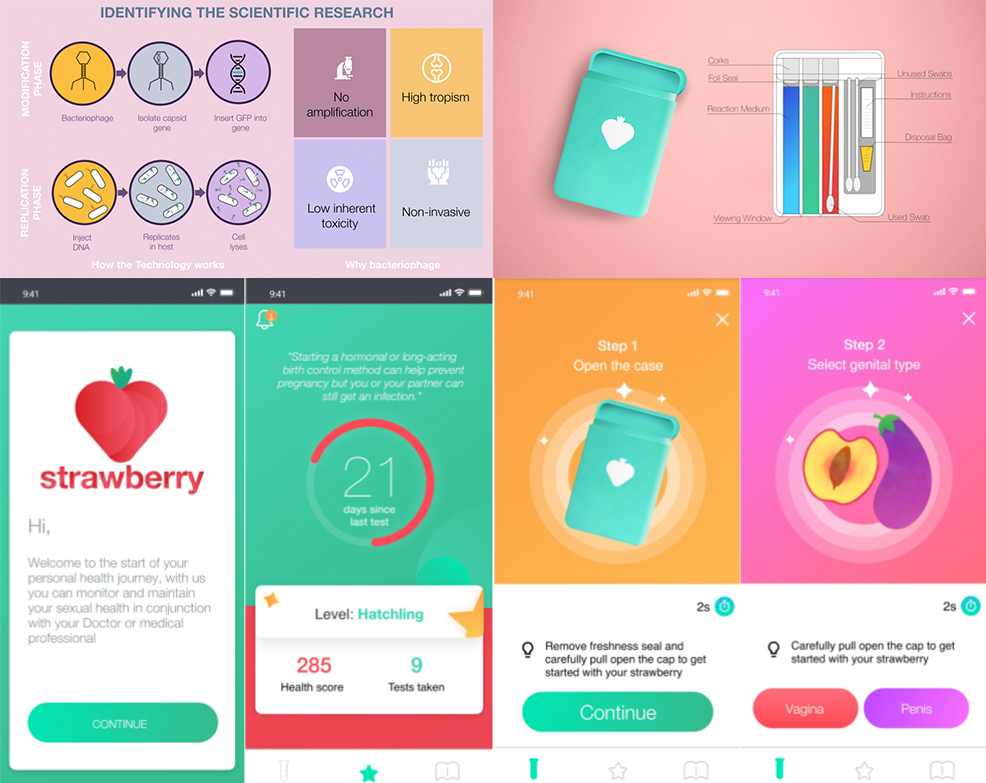Biodesign applies natural and modified properties and abilities of living things to design problems. For example, a mushroom that forms a solid mass as it grows can be turned into a lightweight brick or animal-free leather, a bacteria that glows in response to chemical or physical changes in its environment can be turned into a sensing and feedback system. Sensing the environment in some way and providing feedback is the basic building block of all interactive systems.

Students participating in the International Biodesign Challenge student competition developed speculative solutions that combine cutting edge life science research with user-centred design methods to address challenges in health and wellbeing.
One project, Strawberry, asked the question “how can young people take control of their own sexual health?” The Strawberry project combined user-centred design research into the needs and challenges faced by young people, with research in life sciences. The project shows how tests for three common STI infections can be detected and identified using modified viruses that naturally infect the bacteria, which cause an infection in humans, but also how this can be done in a way that increases accessibility, autonomy and confidence in partners.
Another project Illuminate Pressure helps clinicians by identifying patients who are at risk of developing pressure injuries in hospital as early as possible with a mattress topper. Based on the behaviour of the Hawaiian Bobtail Squid, as the patient lays on the mattress, water is forced out of cells over time, leaving specially cultured bacteria inside. These bacteria spontaneously start to glow when they become too crowded. This glow can be detected by a digital system and provide feedback to the nurse, who can decide whether a patient needs to be turned, to avoid pressure injuries.
The MyHeel project helps people who are at risk of developing foot ulcers, to help them monitor their own health. The system combines a mobile app and electronic sensors in a shoe insole with composite mycelia materials. These materials are made by the roots of some mushrooms (such as Reishi and Oyster mushrooms) which bind together wood or waste cardboard as it grows. This material will allow more sustainable production, which contributes to the circular economy by giving value to waste material, while also giving people more agency to monitor their own health.
People
- Dr Phillip Gough
- Dr Naseem Ahmadpour
- Dr Martin Tomitsch
- Dr Soojeong Yoo (UCL)
- Rayza De Souza (Hounours Student)
Publications
- Gough, P., Yoo, S., Tomitsch, M., & Ahmadpour, N. (2021). Applying Bioaffordances through an Inquiry-Based Model: A Literature Review of Interactive Biodesign. International Journal of Human–Computer Interaction, 37(17), 1–15.
- Gough, P., Forman, J., Pataranutaporn, P., Hepburn, L.-A., Ramirez-Figueroa, C., Cooper, C., Vujic, A., Kong, DS., Kim, R., Maes, P., Ishii, H., Sra, M., Ahmadpour, N. (2021). Speculating on Biodesign in the Future Home. In Extended Abstracts of the 2021 CHI Conference on Human Factors in Computing Systems (pp. 1–5). New York, NY, USA: ACM.